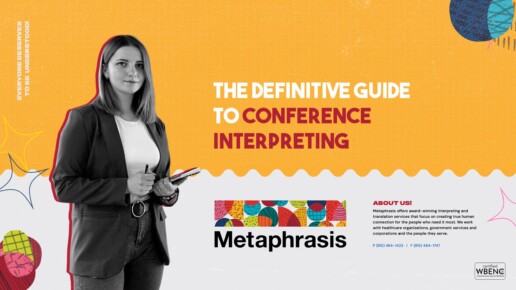The Definitive Guide to Conference Interpreting
In today’s interconnected world, effective communication is key to successful international conferences, business meetings, and global summits. However, language barriers can often hinder seamless communication. This is where conference interpreting plays a crucial role. Whether it’s a multinational business event, an academic seminar, or a diplomatic gathering, skilled interpreters help ensure smooth cross-linguistic communication.
One of the leading providers of high-quality interpretation services is Metaphrasis. They specialize in breaking down language barriers, facilitating effective communication, and enhancing cultural understanding.
In this blog we explores the essentials of conference interpreting, including the different modes of interpretation, necessary equipment, event planning recommendations, and how Metaphrasis can help you make your multilingual event a success.
Differences between Simultaneous and Consecutive Interpreting
Conference interpreting primarily falls into two categories: simultaneous interpreting and consecutive interpreting. While both serve the same purpose—ensuring effective communication between speakers of different languages—they differ in execution and use cases.
Simultaneous Interpreting
Simultaneous interpretation is when the interpreter translates the speech in real time while the speaker continues speaking. This type of interpretation requires specialized equipment and a high level of skill, as interpreters must listen, comprehend, and speak simultaneously.
- Best for: Large conferences, international summits, and events with multiple languages.
- Pros:
- Instantaneous communication without pauses.
- Ideal for live broadcasts and events with large audiences.
- Cons:
- Requires soundproof booths, headsets, and audio systems.
- Demands intense concentration; interpreters usually work in pairs.
Consecutive Interpreting
In consecutive interpreting, the speaker talks in segments, pausing to allow the interpreter to translate after each portion. This method is slower but requires less equipment and allows for more accurate translation.
- Best for: Business meetings, medical consultations, and legal proceedings.
- Pros:
- More precise and allows for cultural nuances.
- Requires minimal equipment.
- Cons:
- Takes more time due to the pause-and-translate process.
- Not suitable for fast-paced events.
Choosing between simultaneous and consecutive interpreting depends on the nature of your event, audience size, and technical requirements.
Types of Interpreting Equipment
For a successful multilingual event, selecting the right interpreting equipment is essential. Here are the most commonly used tools:
Interpretation Booths
Used for simultaneous interpretation, these soundproof booths allow interpreters to work without distractions. They are equipped with microphones, headsets, and audio controls.
Headsets and Receivers
Attendees listen to the interpretation through wireless headsets, ensuring clarity and minimal background noise.
Microphones and Audio Consoles
Microphones are essential for interpreters to clearly transmit their voice, while audio consoles manage sound distribution.
Portable Interpretation Systems
For small-scale meetings or guided tours, a portable system with a transmitter and wireless receivers can be a cost-effective alternative.
The type of equipment you need depends on the event size, interpretation method, and venue setup.
Recommendations for Event Planning
Planning a multilingual conference requires careful preparation to ensure smooth interpretation. Below are essential recommendations for a well-organized event.
Immediately Before the Event
Identify Language Needs: Determine which languages need interpretation. This affects both the choice of interpreters and equipment.
Hire Professional Interpreters: Work with qualified interpreters or a reliable agency like Metaphrasis to ensure accuracy.
Set Up the Venue Properly: Ensure booths, headsets, and sound systems are tested in advance.
Brief the Interpreters: Provide them with event materials, speaker notes, and industry-specific terminology.
During the Event
Ensure Clear Communication: Speakers should talk at a moderate pace to allow interpreters to translate effectively.
Monitor Equipment Performance: Have a technician on standby to handle any technical issues.
Provide Breaks for Interpreters: Simultaneous interpreters work in shifts due to the demanding nature of their job.
By following these recommendations, you can ensure a seamless interpretation experience for your event.
About Metaphrasis Language & Cultural Solutions, LLC
Metaphrasis is a trusted language services provider specializing in conference interpreting, translation, and cultural consulting. Their team of professional interpreters ensures high-quality, accurate, and culturally appropriate communication for diverse events.
Why Choose Metaphrasis?
Experienced Interpreters: Skilled in various fields, including business, healthcare, and legal interpreting.
Equipment: Provides top-tier interpreting tools for smooth execution.
Customized Solutions: Tailored services to meet specific event needs.
Commitment to Excellence: Focuses on quality, professionalism, and cultural awareness.
With Metaphrasis, you can be confident that your multilingual event will be a success. Whether you need simultaneous interpretation for a global conference or consecutive interpretation for a business meeting, their team is ready to assist.
Conclusion
Conference interpreting is an essential service for breaking down language barriers in international events. Choosing between simultaneous and consecutive interpretation, selecting the right interpreting equipment, and following best event planning practices can make a huge difference in the success of your conference.
Metaphrasis Language & Cultural Solutions, LLC is a trusted partner in delivering high-quality interpretation services tailored to your event’s needs. With their expertise and commitment, you can ensure clear, effective, and culturally sensitive communication for all participants.

